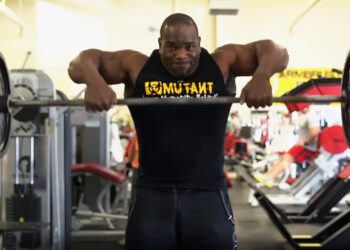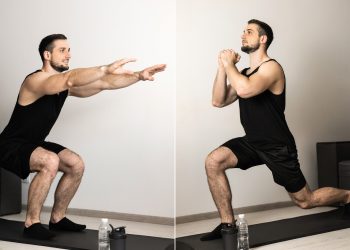Lots of exercises are labeled as “the best,” but such accolades are purely subjective. Squats are often described as the king of exercises and the best way to build and condition your lower body. In contrast, deadlifts are often considered the best exercise for building brute strength. The bench press is everybody’s favorite chest exercise, while push-ups are probably the most widely performed exercise on the planet.
However, when it comes to core training, the plank is commonly viewed as a must-do exercise.
Planks feature in Yoga and Pilates and are as simple as they are effective, and that’s a big part of their appeal. You get down on your elbows and toes, brace your abs, and then hold your position…
And that’s where the trouble starts. As you progress from a beginner to a more experienced exerciser, you will find yourself planking for longer and longer durations. Strong exercisers can plank for several minutes at a time, making your workout far less time-efficient than it could be.
Keep on planking, and you could find yourself approaching the frankly unbelievable Guinness World Record for non-stop planks of 9 hours, 38 minutes, and 47 seconds, achieved by Josef Šálek in Pilsen, Czech Republic, on May 20, 2023 (1).
But there’s a point with planks where longer durations don’t necessarily equate to better results. It might be time to switch to a more demanding exercise. In this article, we delve into weighted planks, revealing why and how to do this exercise and exploring effective alternatives.
Level Up Your Fitness: Join our 💪 strong community in Fitness Volt Newsletter. Get daily inspiration, expert-backed workouts, nutrition tips, the latest in strength sports, and the support you need to reach your goals. Subscribe for free!
Weighted Planks – Muscles Worked
For such an apparently simple exercise, there is a lot going on when you do weighted planks. The most active muscles during this exercise include:
Agonists:
Agonists are the most active muscles during an exercise. They are the reason you are doing that particular exercise in the first place. Think of agonists as the target muscles.
- Rectus Abdominis: This is the main muscle of the abdomen, often referred to as the “six-pack” muscle. It’s primarily responsible for flexing the lumbar spine. However, during weighted planks, it works to prevent lumbar extension.
- Transverse Abdominis: This deep layer of abdominal muscles encircles your midsection like a weightlifting belt. It helps stabilize your lumbar spine by increasing intra-abdominal pressure.
Synergists:
Synergists are helper muscles. They’re working hard but aren’t usually as active as the agonists. You can think of synergists as secondary muscles working alongside the agonists.
- Deltoids: Located on the shoulders, they help support the body’s weight, especially in the forearm plank position.
- Pectoralis Major: This is the primary chest muscle, which helps stabilize the upper body during the plank.
- Serratus Anterior: Located on the side of your chest, this muscle helps keep the shoulder blades against the ribcage.
- Rhomboids and Trapezius: These muscles stabilize the upper back and shoulder blades.
- Latissimus Dorsi: These large muscles of the back help stabilize the body during the plank.
- Hip Flexors (Iliopsoas): Located in the front of the hip, they help stabilize the pelvis.
- Quadriceps: Located on the front of the thigh, they help keep the legs straight during the plank.
Stabilizers:
Stabilizers help prevent unwanted movement. They fix nearby joints in place so the agonists and synergists can generate maximum force.
- Erector Spinae: These muscles run along your back from the base of your skull to your sacrum. They help to keep your back straight during the plank.
- Obliques (Internal and External): These muscles are on the sides of your abdomen. They assist in bending and twisting your lumbar spine.
- Quadratus Lumborum: Located in the lower back, this muscle plays a crucial role in stabilizing the spine.
- Gluteus Maximus and Medius: These are your primary butt muscles. They help stabilize your pelvis during the plank.
- Adductors: These are the inner thigh muscles, which help keep the legs together during the plank.
When adding weight to the plank, the demand on all these muscles increases, as they have to work harder to stabilize the body and maintain the plank position. As such, it is essential to use proper form to engage these muscles effectively and avoid potential injuries.
How to Do Weighted Planks
Get more from weighted planks while keeping your risk of injury to a minimum by following these guidelines:
- Kneel down and place your elbows on the floor so they’re roughly shoulder-width apart. Your forearms should be parallel.
- Ask your training partner to gently place a weight plate on your back. Avoid placing the weight directly onto your lumbar spine if possible. Brace your abs.
- Carefully walk your feet out and back until your body is straight, taking care not to dislodge the weight.
- Without holding your breath or lifting or lowering your hips out of alignment, maintain this position for the required duration.
- On completion, ask your partner to remove the weight plate.
- Rest a moment and repeat.
Pro tips:
- Rest your elbows on a folded exercise mat or foam pad for comfort.
- Do not hold your breath, as doing so can cause a significant rise in blood pressure and could make you feel dizzy or faint.
- Contract your glutes, legs, chest, and shoulders, and clench your fists to generate full body tension.
- Do not use too much weight too soon – even a small weight will make this exercise considerably more challenging.
- Consider using a weighted vest if you are training alone.
Weighted Plank Benefits and Drawbacks
Not sure if weighted planks deserve a place in your workouts? Consider these benefits and then decide!
Shorter sets – more time-efficient workouts
The most common way to make planks more challenging is to do them for ever-increasing durations. That’s okay when you’re planking for 1-2 minutes. However, after that, doing planks can become very time-consuming. Switching to weighted planks will reduce the amount of time it takes to fatigue your core muscles, making your workout far more time efficient.
Another way to progress your workouts
Adding weight is one of the most convenient ways to make strength training exercises more challenging. This is called progressive overload. With bodyweight planks, it is the only form of progression is time.
Using weighted planks, you can keep the duration the same, e.g., 30 seconds, and gradually increase the load week by week. This is an excellent alternative to simply planking for longer.
Build strength rather than endurance
Planking for longer develops muscular endurance, which is your body’s ability to resist fatigue. In contrast, adding weight targets your strength, which is your ability to generate force. While high levels of endurance can be beneficial, so too is strength. With the option of increasing the weight, you can now do planks to improve endurance or strength according to your needs and goals.
Teaches you to generate full-body muscular tension
You can do bodyweight planks with very little thought about what your arms and legs are doing. After all, the load is minimal. But, when you start piling on the pounds, you’ll need to tense your entire body to support the extra weight, and planks turn into a full-body exercise. Learning to create tension throughout your body is a valuable skill that will improve many aspects of athletic performance.
While weighted planks are a mostly beneficial exercise, there are also a couple of drawbacks to consider:
Getting the weight into position alone can be tricky
The best way to do weighted planks is with a training partner to help you get the load in position. They can also remove the weight at the end of the set. Training alone makes getting set up for weighted planks more challenging.
However, with practice, you can do weighted planks alone. You can lie on your front and tilt your weight plate onto your back or lower it behind your head with one hand and then position it on your back with the other. Needless to say, both of these techniques require practice and may be impractical with very heavy loads.
You must stay completely still, or you may drop the weight
While you should try to stay still during weighted planks, you’ll probably fidget and shake when doing this exercise. This could cause the weight plate to shift, and you could even drop it. This is especially likely if you use small-diameter plates or have a stack of weights. Needless to say, unstable weight plates could cause injury, especially if they fall and hit you on the back of the head. Ideally, you should have a spotter on hand for this exercise.
Increased risk of injury
Planks are a pretty safe exercise, as are most basic bodyweight movements. However, using weights means more stress on your muscles and joints, and even minor technical errors could cause injury. For example, if you allow your hips to drop out of alignment, the pressure on your back will increase exponentially.
Some exercisers also rush to use very heavy weights, often exceeding their strength and technical ability. This also increases the injury risk. Avoid potential problems by monitoring your form and increasing the load gradually.
10 Best Weighted Plank Variations and Alternatives
Weighted planks are a highly effective core exercise, but that doesn’t mean you need to do them all the time. There are plenty of variations and alternatives you can use to keep your workouts productive and interesting:
1. Weighted high plank
You don’t have to do planks on your elbows – the so-called low plank position. High planks resemble the start point for push-ups, and they work your shoulders, chest, and arms more than low planks. Take care that your weight plate doesn’t slide down your back when you do this variation.
Steps:
- Adopt the push-up position with your arms and legs straight, and your core braced.
- Ask your training partner to gently place a weight plate on your back.
- Without holding your breath or lifting or lowering your hips out of alignment, maintain this position for the required duration.
- On completion, ask your partner to remove the weight plate.
- Rest a moment and repeat.
Tips:
- Tense your entire body to support the extra load.
- Place your hands roughly shoulder-width apart for maximum stability and strength.
- Tuck your chin to avoid straining your neck.
2. Dip belt weighted plank
Dip belts are good for more than making chin-ups, pull-ups, and dips more challenging. In fact, you can also use them for weighted planks. This exercise variation is ideal for anyone who trains alone. However, you will need a pair of benches or boxes for this exercise.
Level Up Your Fitness: Join our 💪 strong community in Fitness Volt Newsletter. Get daily inspiration, expert-backed workouts, nutrition tips, the latest in strength sports, and the support you need to reach your goals. Subscribe for free!
Steps:
- Position two benches or boxes the correct distance apart so you can plank with your feet on one platform and your arms on the other.
- Put your dip belt around your waist, loaded with an appropriate weight.
- Lean forward and place your forearms on the front box and your feet on the rear box. Brace your abs and straighten your legs and body.
- Without holding your breath or lifting or lowering your hips out of alignment, maintain this position for the required duration.
- Rest a moment and repeat.
Tips:
- You can also do this exercise with straight arms, i.e., a high plank.
- Make sure your dip belt chain is short enough that the weight doesn’t touch the floor.
- This setup is also ideal for weighted push-ups.
3. Plank with arm lift
Adding weight is not the only way to make planks more demanding and, therefore, time efficient. Reducing the number of contact points with the ground also increases the challenge. In addition, doing planks with an arm lift increases oblique activation.
Steps:
- Adopt the push-up position with your arms straight and core braced.
- Without lifting or twisting your hips or shoulders, slowly extend one arm out in front of you.
- Return your hand to the floor, switch arms, and repeat.
- Continue for the desired duration.
Tips:
- You can also do this exercise while resting on your forearms.
- Do this exercise for reps instead of time if preferred.
- Drive the palm of your hand into the floor to engage and stabilize your upper body.
4. Plank with leg lift
Planks with a leg lift are a little easier than planks with an arm lift but more challenging than weighted planks. Like exercise #3, this exercise increases the load on your core muscles and obliques, which must work harder to stabilize your hips and waist.
Steps:
- Adopt the low plank position so your body is straight and you’re resting on your forearms. Brace your core.
- Keeping your hips level, lift one leg and raise your foot off the floor.
- Lower your leg, switch sides, and repeat.
- Continue for the desired duration.
Tips:
- You can also do this exercise in the high-plank position.
- Do this exercise for reps instead of time if preferred.
- Take care not to hyperextend your lower back as you lift your leg. Do not raise your foot too high. A few inches will suffice.
5. Contralateral plank
Contralateral means opposite arm and leg, which means you’ll be balancing on just two points of support for this exercise. This is extremely challenging, even using just your body weight. So, make sure you have built some basic core strength with arm and leg lift planks before attempting this move.
Steps:
- Adopt the high plank/push-up position with your arms and legs straight and core braced.
- Lift one arm and the opposite leg. Hold for the designated time.
- Return your hand and foot to the floor, switch sides, and repeat.
Tips:
- Try not to lift your hips, as doing so makes this exercise easier and less effective.
- Bend your legs and rest on your knees to make this exercise less challenging. This is called a bird dog.
- Only attempt this exercise if you have mastered arm and leg-lift planks.
6. Renegade row
Don’t let the name of this exercise put you off; despite being a type of row, this is still a very challenging core exercise. Popularized by football strength and conditioning coach John Davies, this exercise teaches you how to integrate your core with your arms and legs. This is a very functional exercise, and it’s pretty darn tough, too!
Steps:
- Holding a dumbbell in each hand, get on the floor in the push-up position. Your arms and legs should be straight, with your core braced.
- Bend one arm and row the dumbbell into your ribs.
- Extend your arm, place the weight back on the floor, and switch sides.
- Continue alternating arms for the required number of reps.
Tips:
- Use hex-shaped dumbbells so your weights won’t roll away.
- Combine with push-ups for an even more demanding upper body and core workout.
- You can also do this exercise with kettlebells.
7. RKC Plank
One of the less obvious ways to make planks more challenging and time efficient involves tensing your muscles harder. This is called the Russian Kettlebell Challenge (RKC) plank. The RKC plank looks easy, but if done right, you should be able to fatigue your core in 20 seconds or less. If you can go for longer, you aren’t doing it right!
Steps:
- Adopt the low plank position.
- Clasp your hands together and brace your core. Tense your arms, legs, and glutes.
- Contracting your entire body as hard as you can, hold this position for 10-20 seconds.
- Relax, rest a moment, and repeat.
Tips:
- Do not hold your breath, as doing so can elevate your blood pressure and make you feel faint.
- Set a timer and try to fatigue your core before the time runs out.
- Too easy? Tense your muscles even harder.
8. Stir the pot
Planks are a very stable exercise. After all, the floor doesn’t move, and your body should remain stationary, too. This plank variation introduces a significant element of instability, which will challenge your core muscles without resorting to using additional weight.
Steps:
- Adopt the plank position with your forearms resting on a stability ball. Brace your core and make sure your legs and body are straight.
- Make small circles with your arms clockwise and counterclockwise. Use your core to keep your body stable.
- Continue for the prescribed reps or duration.
Tips:
- Move your arms in bigger circles to make this exercise more challenging.
- Bend your legs and rest on your knees to make this exercise easier.
- Smaller stability balls make this exercise harder than big balls.
9. Suspension trainer planks
Like stir the pots, this exercise creates instability, so your muscles must work harder to hold you in the correct position. This added instability also makes exercises like planks more functional, as, in nature, your muscles often have to work in an unstable environment.
Steps:
- Adopt the push-up position and place your feet in the stirrups of a suspension trainer, such as a TRX. Brace your core.
- Hold this position for the designated duration.
- Bend your legs, lower your knees to the floor, and rest.
- Repeat for the prescribed number of sets.
Tips:
- You can also do this exercise in a low plank position, i.e., resting on your elbows.
- Swing your body forward, backward, and sideways a few inches to make this exercise harder.
- Ask a training partner to gently and unpredictably move your feet, so you have to respond quickly to an unstable form of stress.
10. Rollouts
Rollouts are basically a moving plank. They involve extending your arms in front of you, which lengthens the lever and increases the weight on your core. In addition to hammering your abs, rollouts are also an excellent lat and shoulder exercise. However, they’re also pretty challenging.
Steps:
- Kneel down and place your ab wheel on the floor in front of you. Straighten your arms and brace your core.
- Push the wheel away from you and lower your chest and abdomen down toward the floor. Do not hyperextend your spine.
- Pull the wheel back up to your legs and repeat.
Tips:
- No ab wheel? No problem; you can also do this exercise with a barbell.
- Do this exercise in front of a wall to stop the ab wheel from rolling too far.
- Do rollouts from standing for a far more challenging workout:
Weighted Planks FAQs
Do you have a question about weighted planks, or core training in general? That’s okay because we’ve got the answers!
1. What’s the difference between weighted planks and regular planks?
Weighted planks are an advanced variation of the traditional plank exercise. Adding weight to your back increases the resistance and challenge, making your core muscles work harder. This can lead to increased strength and endurance over time compared to regular planks.
2. Where should I place the weight during a weighted plank?
The ideal position for the weight is on the upper back, between the shoulder blades. Placing it too low can put undue stress on the lower back, while setting it too high can cause neck or shoulder discomfort. Experiment with the position of the weight to find what works best and feels the most comfortable for you.
3. How much weight should I use for weighted planks?
There are plenty of examples of people doing weighted planks with frankly eye-watering weights. However, using too much weight too soon can be risky and lead to serious injury. So, don’t be in a hurry to pile on lots of weight straight away.
Instead, start with ten pounds/five kilos and see how that feels. If that’s too easy, increase the weight and try again. If you can plank for more than 60 seconds, the weight is probably too light. But, if you can only last 10-15 seconds, it’s too heavy.
While it will take a few workouts to determine the correct load for weighted planks, this gradual approach will save you from unnecessary aches and pains.
4. How often should I do weighted planks?
It takes about 48-72 hours for your muscles to recover from an intense workout. Training the same muscle more often than this could lead to overtraining and suboptimal progress. Therefore, you should do weighted planks 2-3 times per week, with at least one day of rest between workouts.
If you are new to weighted planks or core training in general, twice a week will suffice. More experienced exercisers may benefit from working their core more often. However, even elite athletes need to allow time for rest and recovery.
5. Will weighted planks give me a six-pack?
While weighted planks will thicken your abdominal wall and make your abs more contoured, you may not be able to see it if your body fat percentage is too high. For your abs to be visible, your body fat percentage needs to be 10% or less for men and below 15% for women.
It’s entirely possible to have great abs, but never see them if your body fat percentage is too high. As such, getting six-pack abs is as much to do with your diet as your workout program.
Read more about getting a shredded six-pack here.
6. Weighted planks hurt my lower back – what gives?
While you should expect to feel your core working during weighted planks, back pain suggests something is not quite right. Possible causes of back pain during weighted planks include:
- Allowing your hips to drop and hyperextending your spine
- Using too much weight
- Weak core muscles
- Tight hip flexors
- Placing the weight too low on your back
- Not bracing your abs hard enough
- Previous injury
Assess your weighted plank performance to see if there are any obvious reasons for your pain. Make adjustments as necessary. It may be that you need to do some preparatory exercises before returning to weighted planks.
7. Can beginners do weighted planks?
While most beginners can eventually progress to weighted planks, it’s essential to master regular planks first. Once you can hold a standard plank with good form for at least 60 seconds, you can consider adding a light weight and gradually increasing it as your strength improves.
Weighted Planks – Wrapping Up
Planks are a great exercise, and they’re rightly popular. However, once you can plank for two minutes or more, they start to lose some of their effectiveness and become less time-efficient.
There are several ways to make planks more challenging, including using three or two points of support and doing them on an unstable surface. However, adding weight is arguably more straightforward and beneficial.
However, it is critical that you earn your right to do weighted planks by first mastering the basic unweighted version. If you can’t do a solid plank for 60 seconds, you are not ready for weighted planks.
But, if you are ready for the challenge, weighted planks are a great way to build a strong and capable core. However, introduce them gradually and increase the weight over time to minimize your risk of injury.
We LOVE weighted planks and think you will, too, so try them in your next core workout.
References:
1 – Guinness World Records: Man’s incredible physical feat as he holds abdominal plank for almost 10 hours.
Interested in measuring your progress? Check out our strength standards for Bench Press, Push Ups, Pull Ups, and more.










